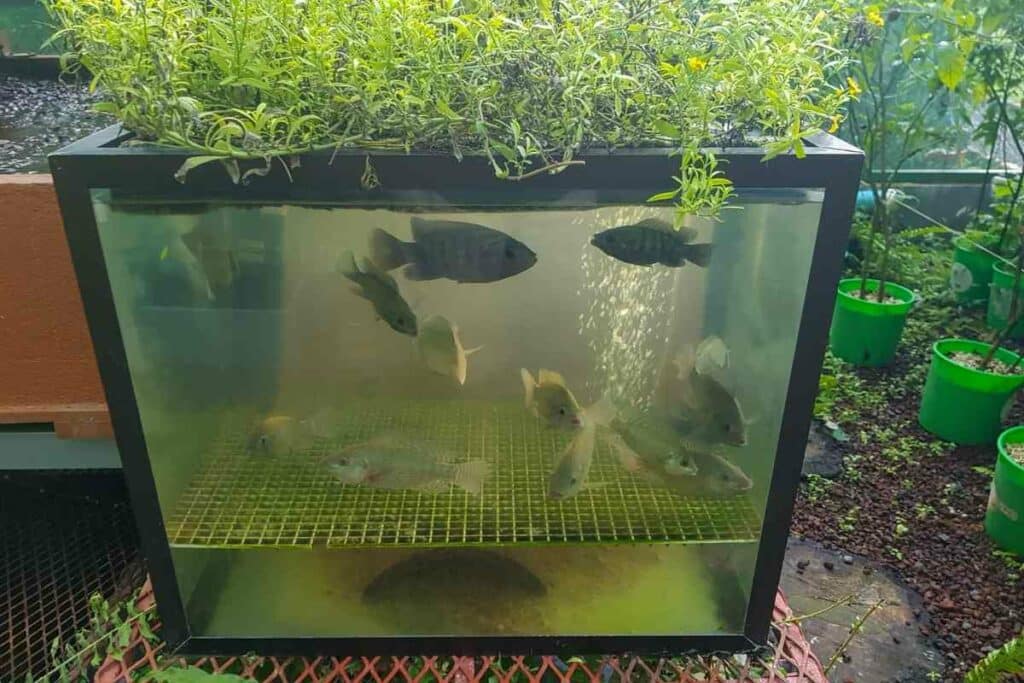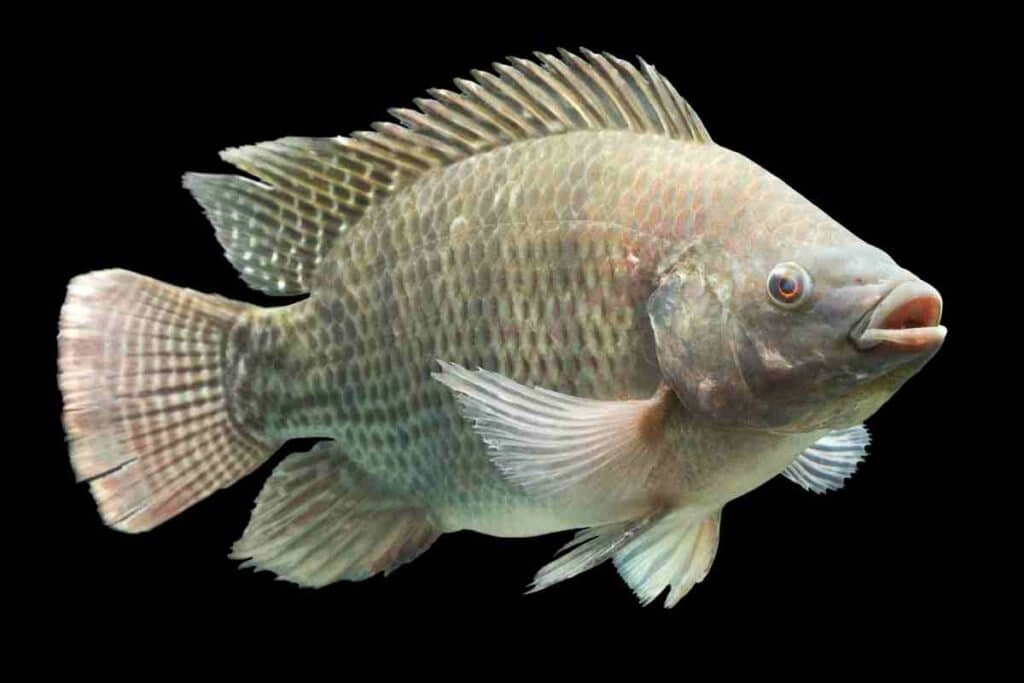Aquaponics is a system that allows for fish to grow in water and then be used as fertilizer for plants.
Tilapia is one type of fish that is ideal for this purpose, but does tilapia work well in an aquaponics environment?
Tilapia in aquaponics will thrive in an aquaponic system. They are hardy and adapt quickly to the different conditions found in aquaponics systems. They also produce more waste than many other types of fish, which helps with plant growth by providing extra fertilizers.

Why Tilapia for Aquaponics?
Tilapia is an excellent choice for aquaponics because they reproduce fast. They can be a good choice in a system where the fish feed on plant-based food, such as duckweed.
Tilapia can breed in water temperatures between 1 °and 30° Celsius.
That makes them hardy and enables them to withstand the wide range of water conditions in an aquaponics system.
They are often farmed for their meat, creating incentives to make sure they grow quickly and healthily.
There is no need to feed tilapia anything that isn’t plant-based because they can digest vegetation.
Their hardiness and ability to adapt greatly benefits an aquaponics system with widely varying water conditions depending on the season.
In addition, they can breed in many different water types, including those with low oxygen levels.
Since tilapia are mainly kept for food production, there’s widespread knowledge about their dietary needs.
They require a limited amounts of protein to grow properly. That makes them a good choice for aquaponics systems, where plant-based foods make up most of their diet.
Tilapia can survive and even thrive in a wide range of oxygen levels. That is due to the thick skin that keeps them insulated. It also protects them from exposure to cold air during the winter months.
You can use it as food in its whole or crushed form. That translates well into the aquaponics environment, where fish are grown until they are large and ready to eat, harvested, and fed straight to other types of fish.
They are disease resistant – another reason why they are such a great choice for an aquaponics system.
They have no natural predators in the wild, which means they aren’t afraid of anything, including humans. That makes them an easy fish to care for and manage.
Their healthy diets make tilapia good environmental choices because there is little waste when farmed on a small scale.
In addition, their need for such large amounts of vegetation ensures that their waste gets utilized by plants instead of getting wasted on empty tank bottoms.
The Best Vegetables For Tilapia Growth In Aquaponics
Below are some plants that do well with tilapia in aquaponics.
Beans
Beans are suitable for aquaponics systems because they mature fast and produce a lot. They also need to be harvested frequently, which helps keep the system well-maintained.
Carrots
You can plant carrots in your aquaponics system to get quick, nutritious food that is easy to prepare. Carrots take only a few weeks to grow, making them great for aquaponics.
Tomatoes
They are ideal because they produce large amounts of fruit in return for little effort and resources.
That makes them well-suited to the efficient environment found in aquaponics systems. They are also versatile in use, making them a solid choice.
Lettuce
This is an ideal plant for aquaponics systems because they are easy to grow.
You can harvest lettuce multiple times per year which ensures you have access to fresh vegetables without too much effort.
Why You Should Feed Plankton To Your Tilapia
For tilapia to flourish in an aquaponics system, it is necessary to feed them a diet of plankton before moving them into the aquaponics environment.
Plankton are small organisms that live in water and are an excellent nutrient source for tilapia and other varieties of fish.
Although you may not find tilapia around your local pond or lake often, the fish is one of the popular varieties because of its ability to adapt to different environments.

Where Can You Get Tilapia?
It’s possible to get tilapia from your local pet store. It may be difficult to find them at aquarium stores.
Before purchasing tilapia, check the water conditions and make sure there are no signs of illness or disease present.
How To Take Care Of Your Tilapia
Once you’ve gotten the tilapia in your aquaponics system, it’s essential to ensure their living conditions are at their optimum.
This means checking temperatures and making sure there aren’t any instances of illness or injury present.
If possible, create an environment where there’s both sunshine and shade so that tilapia can adapt quickly during different times of the day.
Types Of Tilapia Fish You Can Use In Aquaponics
Blue Tilapia
It’s ideal for systems where water temperatures are cold. They can survive in temperatures ranging from 1° Celsius up to about 30° Celsius.
This makes them perfect for areas where temperatures are extremely cold as it will save you from buying expensive equipment.
They feed mainly on phytoplankton and the adults are mainly herbivores. It has a slow maturity but people love it for its tasty meat.
The Mozambique tilapia

Not only is this fish tasty, but it also does well in saline waters. Additionally, it can survive for short periods in water with almost no oxygen, making it fit for aquaponics systems.
It thrives in water with a pH range between 5 and 9. Their female releases hundreds of young per spawn when breeding making it ideal for a commercial setting.
The Nile tilapia
This is a hardy one making it a good choice for aquaponics systems where water temperature or other conditions could be problematic for other types of fish.
It can survive at temperatures ranging from 1° Celsius to 30° Celsius. They are also adaptable to different water conditions and can tolerate low oxygen levels, unlike many types of fish.
It’s a fresh water fish and as such, will not survive for long in saline water in contrast to the Mozambique.
Tilapia Feeding Guide For Best Aquaponics Growth
For aquaponics systems, tilapia fish need a mostly vegetarian diet that consists of the green algae called spirulina and duckweed.
These two foods naturally grow in most aquaponics systems since the nutrient-rich water that fish live in is a good breeding ground for them.
Tilapia should also have access to other food, such as brine shrimp, bloodworms, daphnia, and tubifex.
In addition, tilapia can feed on earthworms from the land if you add a little variety to their diet.
Feeding Chart For Tilapia Under Ideal Conditions
| Fish Size (g) | Feed Size | Feed Rate(%) |
| Post Hatch -0.6 | 1 Crumb | 20-16 |
| 0.6-5 | 2 Crumb | 16-10 |
| 5-19 | 3 Crumb | 10-5 |
| 19-76 | 1mm Pellet/Crumb | 5-2 |
| 76-151 | 3mm Pellet | 2-1.5 |
| 151-Market | 5mm Pellet | 2-1.5 |
What Are Some Problems Involved With Keeping Tilapia?
Although tilapia is versatile, there are a few things you should keep track of before adding them to your aquaponics system.
Since they thrive on plankton diets, it’s important to keep their food supply well maintained, or else they will eat vegetation in your aquaponics system, which can lead to nutrient problems.
Tilapia like fighting with each other, especially when food is scarce, so you have to provide them with more than one feeding station if possible.
They breed and multiply really quickly which can hurt your system.
Therefore, you need to control their breeding so they don’t interfere with your system and end up eating the roots of the plants.
FAQs
Q1. How long can tilapia survive without oxygen?
A1. Tilapia can go for 24 hours or more in water with little to no oxygen.
Q2. How do tilapia have sex?
A2. Tilapia have internal fertilization, where the male releases sperm into the female’s vent, and they get deposited inside of her. The process is known as spawning.
Q3. How much food should tilapia eat?
A3. According to the statistics, one tilapia may eat up to 3% of its body weight each day.
You can feed your fish daily or several times per day, depending on the size of your tank and how many fish you have inside.
Feed them small pellets that are rich in protein but low in fat.
Q4. How big do tilapia get?
A4. The average size of a full-grown tilapia is between 12-18 inches long and weighs about 1-2 pounds.
The biggest recorded catch was 24 inches and 9.6 pounds.
Q5. What do tilapia eat?
A5. As mentioned earlier, the primary food source for tilapia is phytoplankton.
They will also eat zooplankton, insects, small fish, worms, snails, carp eggs, and vegetation in the wild.
In an aquarium or aquaponics system, you can feed them on a diet of fish pellets or flakes designed for omnivores.
Q6. How fast can tilapia grow?
A6. The growth rate of tilapia varies with the environment they are raised in and what they eat. In ideal conditions, they can reach maturity and full size within a year.
Conclusion
Adding tilapia in aquaponics is an excellent option because they are hardy and can survive in extreme pH levels.
You can easily add them to your system and produce food in a small space without much work or time investment.
The most important thing is to ensure you monitor your water quality so you raise healthy tilapia.
- Guide To Desert Plants: Types, Adaptations, And Landscaping Tips
- Philodendron Care, Varieties, And Aesthetic Home Arrangements
- Potato Bugs: Identification, Impact, And Control
- What Do Squirrels Eat? A Gardener’s Guide to Squirrel Diets
- Understanding Chipmunks In Your Garden: Behavior, Diet, And Tips For Gardeners
